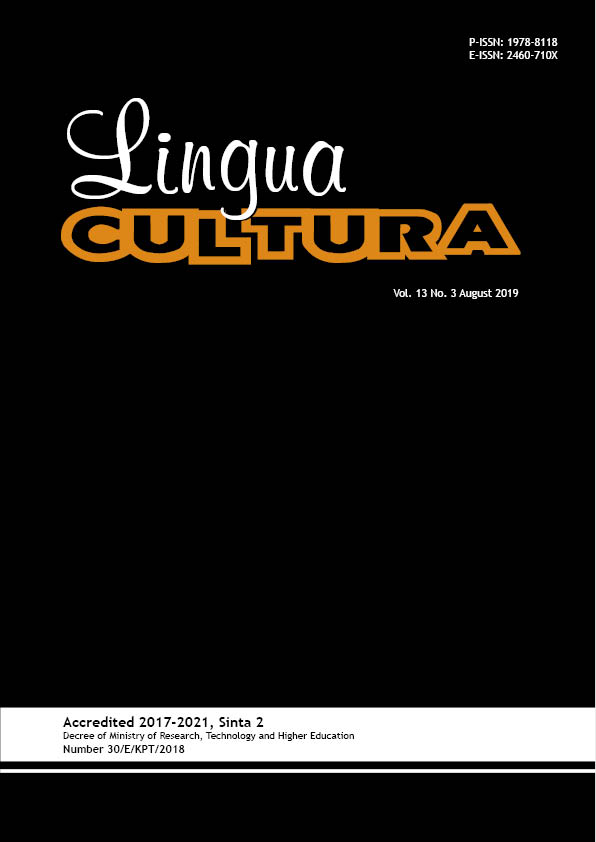Students’ Errors in Using the Simple Present Tense at Polytechnic ATI Padang
DOI:
https://doi.org/10.21512/lc.v13i3.5840Keywords:
error analysis, students` error, simple present tenseAbstract
The research aimed at analyzing the errors in using simple present tense at Logistics Management of Agro-Industry of Polytechnic ATI Padang. A qualitative method with descriptive approach was applied. The samples were 15% of 153 total students or 23 students. Data were collected through the writing test; namely, descriptive essay. The results show that many students commit errors in using the simple present tense. The errors are classified into four types: omission, addition, misinformation, and misordering. There are 107 errors with the highest number that is omission (61 errors or 57%). Misinformation is in second place with 29 errors (27,1%). The error of addition gains 11,2 % with 12 errors. The lowest error is misordering, which gains 4,7% with only five errors. In conclusion, the most dominant error made by the students is omission with 57% and misordering is the lowest one with 4,7%. Therefore, the lecturers are expected to improve the teaching strategies in teaching simple present tense to reduce the numbers of students’ errors.
References
Abdullah, A. T. H. (2013). Error analysis on the use of the simple tense and the simple past tense in writing essays among TESL college students. International Journal of Education and Research, 1(12), 1–12.
Al-Ghabra, I. M. M. M., & Najim, A. S. (2019). Analyzing errors committed in paragraph writing by undergraduates. Journal of Language Teaching and Research, 10(2), 264-270. https://doi.org/10.17507/jltr.1002.07.
Azar, B. S., & Hagen, S. A. (2017). Understanding and using English grammar (5th Ed.). London: Pearson Education ESL. Retrieved from http://weekly.cnbnews.com/news/article.html?no=124000.
Cheng, X. (2015). Interlanguage-based error analysis in higher vocational and technological college EFL education in China. Journal of Language Teaching and Research, 6(3), 639-646. https://doi.org/10.17507/jltr.0603.22.
Gay, L. R., Mills, G. E., & Airasian, P. (2012). Educational Research Competencies for Analysis and Applications (10th Ed.). Boston: Pearson Education.
James, C. (2013). Errors in language learning and use exploring error analysis. Retrieved from http://weekly.cnbnews.com/news/article.html?no=124000.
Kalee, S., Rasyid, Y., & Muliastuti, L. (2018). Error analysis on the use of affixation in Indonesian paper written By Thai Student. Lingua Cultura, 12(3), 289-293. https://doi.org/10.21512/lc.v12i3.4307.
Karim, A., Mohamed, A. R., Ismail, S. A. M. M., Shahed, F. H., Rahman, M. M., & Haque, M. H. (2018). Error analysis in EFL writing classroom. International Journal of English Linguistics, 8(4), 122-138. https://doi.org/10.5539/ijel.v8n4p122.
Katiya, M., Mtonjeni, T., & Sefalane-Nkohla, P. (2015). Making sense of errors made by analytical chemistry students in their writing. Journal of Language Teaching and Research, 6(3), 490-503. https://doi.org/10.17507/jltr.0603.04.
Kusumawardhani, P. (2016). Error analysis in writing an English narrative composition. Lingua Cultura, 9(2), 132-136. https://doi.org/10.21512/lc.v9i2.824.
Mohammed, M. S., & AbdalHussein, H. F. (2015). Grammatical error analysis of Iraqi postgraduate students’ academic writing: The case of Iraqi students in UKM. International Journal of Education and Research, 3(6), 283–294. Retrieved from www.ijern.com.
Murphy, R. (2015). English grammar in use (4th Ed.). Cambridge: Cambridge University Press.
Napitupulu, S. (2017). Analyzing linguistic errors in writing an English letter: A case study of Indonesian undergraduate students. International Journal of Language and Linguistics, 5(3), 71-77. https://doi.org/10.11648/j.ijll.20170503.12.
Silalahi, R. M. (2014). Error analysis on information and technology students’ sentence writing assignments. International of Education and Research, 1(2), 151-166.
Tomakin, E. (2014). Teaching English tenses (grammar) in the Turkish texts; A case of simple present tense: Isıl Maketi Iter. International Journal of Learning and Development, 4(1), 115-131. https://doi.org/10.5296/ijld.v4i1.5154.
Zuhriyah, M. (2017). Problem-based learning to improve students’ grammar competence. Register Journal; Language & Language Teaching Journals, 10(1), 48-61. https://doi.org/10.18326/rgt.v10i1.875.
Downloads
Published
How to Cite
Issue
Section
License
Authors who publish with this journal agree to the following terms:
a. Authors retain copyright and grant the journal right of first publication with the work simultaneously licensed under a Creative Commons Attribution License - Share Alike that allows others to share the work with an acknowledgment of the work's authorship and initial publication in this journal.
b. Authors are able to enter into separate, additional contractual arrangements for the non-exclusive distribution of the journal's published version of the work (e.g., post it to an institutional repository or publish it in a book), with an acknowledgment of its initial publication in this journal.
c. Authors are permitted and encouraged to post their work online (e.g., in institutional repositories or on their website) prior to and during the submission process, as it can lead to productive exchanges, as well as earlier and greater citation of published work.
USER RIGHTS
All articles published Open Access will be immediately and permanently free for everyone to read and download. We are continuously working with our author communities to select the best choice of license options, currently being defined for this journal as follows: Creative Commons Attribution-Share Alike (CC BY-SA)


















